This article was co-authored by David Nazarian, MD. Dr. David Nazarian is a board certified Internal Medicine Physician and the Owner of My Concierge MD, a medical practice in Beverly Hills California, specializing in concierge medicine, executive health and integrative medicine. Dr. Nazarian specializes in comprehensive physical examinations, IV Vitamin therapies, hormone replacement therapy, weight loss, platelet rich plasma therapies. He has over 16 years of medical training and facilitation and is a Diplomate of the American Board of Internal Medicine. He completed his B.S. in Psychology and Biology from the University of California, Los Angeles, his M.D. from the Sackler School of Medicine, and a residency at Huntington Memorial Hospital, an affiliate of the University of Southern California.
There are 9 references cited in this article, which can be found at the bottom of the page.
This article has been viewed 66,752 times.
There are two primary forms of medical release letters. For example, you might draft one if you want a doctor to release your medical records to another person. A different kind of medical release grants an adult the authority to seek medical treatment for your child. You might need to sign one of these releases before your child can go on a field trip or play sports.
Steps
Releasing Your Medical Records
-
1Format your letter. You can set up your letter like a standard business letter. Make sure to use a font that is readable. For example, Times New Roman or Arial 12 point works best. You can address the letter to the doctor or medical provider who maintains the records you want released.[1]
- If you are a medical provider, then you might want to draft a form that your patients can use. Set it up as a template, and insert blank lines for information that will change depending on the patient.
-
2Draft the authorization. You need to explicitly identify which doctor you are giving permission to release your information. You also should identify who they should release your medical records to.[2]
- You could write: “I authorize Piedmont Medical Practice to use and disclose my protected health information described below to Dr. Caryn Smith, 2222 High Street, City, Nevada, 12345.”
Advertisement -
3State the time period for disclosures. You should identify what time period of treatment this release relates to. For example, you could have seen your doctor for the past 10 years, but you only want to release information from the past two years. You should specify.[3]
- Sample language could read: “This authorization for release of health information covers the period of healthcare from August 1, 2013 to April 2, 2016.”
- Alternately, you could state that your release should cover “all past, present, and future periods.”
-
4Identify what information to release. You can release all of your medical information or you can release only certain records. You should specify so that your doctor knows what to release.[4]
- If you want to release everything, then include this language: “I authorize the release of my complete health history (including all information related to HIV or AIDS, mental health care, communicable diseases, or treatment of alcohol and drug abuse).”
- If you only want to release specific records, then you can state exactly what you want released. Alternately, you could state that you release your complete health history except for certain information. State what information should be held back.
-
5Identify how long your authorization is effective. If you don’t give your doctor a date, then they might think the authorization lasts indefinitely. Accordingly, you should state when it expires, which might be a date or an event.[5]
- You can write, “This authorization shall be in effect until August 31, 2016.”
- Or you could write, “This authorization shall be in effect until the date of my surgery.”
-
6Include other general provisions. You also want to include some general statements about your right to withdraw the authorization[6] and how the information may be used. This information is particularly important if you are a medical provider who is drafting a template for your patients to use. Include the following:
- “I understand I may revoke this authorization in writing at any time. My revocation is not effective to the extent someone has already acted on my authorization or if my authorization was obtained so that an insurer can contest a claim.”
- “This medical information may be used by the person I authorize to receive it for medical treatment, consultation, or other purposes as I direct. I understand that my payment, enrollment, eligibility for benefits, or treatment will not be conditioned on whether I sign this authorization.”
- “I understand that the information used or disclosed by this authorization may no longer be protected by state or federal law.”
-
7Sign the release. Your release isn’t effective until you sign it. Accordingly, include the closing words “Thank you” and then include your signature as well as a line for you to print your name. Remember to keep a copy of the release letter for your records.[7]
- Hand deliver the release to your doctor or mail it certified mail, return receipt requested.
Authorizing Treatment for a Child
-
1Format your document. Most schools should have forms for athletic participation or other activities. However, if you are drafting a release for a different situation, then you should set the font to something readable—Times New Roman 12-point type works best.[8]
- You don’t have to type a business letter, though you can if you want. Instead, you can just type up a form so long as it includes all of the necessary information.
- If you are creating a template for parents to use, then include this information as a header: “This form grants temporary authority to an adult to arrange for and provide medical care in the event of an emergency for an unaccompanied minor when it is not possible to contact the parents or legal guardians. Please give your signed form to the trip leader.”
-
2Identify yourself. At the start of the letter, you should identify who you are and your child. Include the child’s full legal name. Also identify the adult you are giving permission to seek medical treatment for your child.[9]
- Sample language could read: “We, Alice and Alexander Smith, hereby grant Melissa Jones of 5555 Southern Drive, Cityscape, NV 12345 the authority to obtain medical treatment for our child, Evan Kevin Smith.”
-
3Include information about your child. Provide essential information so that the adult in charge can identify your child. You should provide the following about your child, which you can list:
- home address
- date of birth
- gender
-
4Name your child’s doctor. Include the name of your child’s doctor, as well as the address of their practice. Also include the phone number, if you know it.[10]
- You should also include medical insurance information, such as the name of the plan and the policy number.
-
5List significant medical information. Include this information so that the doctor can provide appropriate treatment. List allergies to medications as well as any other allergies your child has.[11]
- Also note all treatment your child is receiving. For example, if your child has asthma, then include that information.
- If your child takes medicine, list the medicines and the dosages that they receive.[12]
-
6Authorize treatment. You should specify what treatment you are authorizing the adult to seek for your child. You should be as detailed as possible. Start this section with the words, “I have legal custody of this child and I authorize and consent for Melissa Jones to do the following….” Consider giving the following:[13]
- administer general first aid
- summon emergency medical personnel if the injury is life threatening or requires immediate emergency treatment
- X-rays
- anesthetic
- blood transfusions
- medication
- any other treatment deemed advisable by appropriate medical professionals
-
7Identify how long the authorization is effective. State that you are giving this authorization in advance of any medical treatment and also include the date when it expires.
- For example, you could write: “This authorization is given in advance of any medical treatment. However, it is given to provide the Designated Adult with the expectation that he/she will use their best judgment upon the advice of medical personnel. This authorization is effective through September 1, 2017.”
-
8Sign as parent or legal guardian. You should include your signature, printed name, and the date. You should also have a witness or notary public sign along with you as well.[14]
- You can find a notary at most courthouses, town or city offices, and large banks. Make sure to bring sufficient personal identification, such as a valid passport or state-issued ID. You will probably have to pay a small fee to use a notary.
Expert Interview

Thanks for reading our article! If you'd like to learn more about letter writing, check out our in-depth interview with David Nazarian, MD.
References
- ↑ https://privacyrights.org/resources/sample-letter-request-medical-records
- ↑ https://www.osha.gov/laws-regs/regulations/standardnumber/1910/1910.1020AppA
- ↑ https://privacyrights.org/resources/sample-letter-request-medical-records
- ↑ https://www.osha.gov/laws-regs/regulations/standardnumber/1910/1910.1020AppA
- ↑ https://www.osha.gov/laws-regs/regulations/standardnumber/1910/1910.1020AppA
- ↑ https://www.hhs.gov/hipaa/for-professionals/faq/474/can-an-individual-revoke-his-or-her-authorization/index.html
- ↑ https://privacyrights.org/resources/sample-letter-request-medical-records
- ↑ https://pike.osu.edu/sites/pike/files/imce/Program_Pages/4H/consent%20to%20treat%20health%20form.pdf
- ↑ https://www.dignityhealth.org/content/dam/dignity-health/pdfs/arizona/medical-consent-for-minors-form3213448.pdf
- ↑ https://pike.osu.edu/sites/pike/files/imce/Program_Pages/4H/consent%20to%20treat%20health%20form.pdf
- ↑ http://pike.osu.edu/sites/pike/files/imce/Program_Pages/4H/consent%20to%20treat%20health%20form.pdf
- ↑ https://www.acep.org/globalassets/uploads/uploaded-files/acep/clinical-and-practice-management/resources/pediatrics/medical-forms/consent.pdf
- ↑ https://eoss.asu.edu/sites/default/files/Caregiver%20Consent%20Form%20for%20Medical%20Treatment.doc
- ↑ https://www.ahrq.gov/health-literacy/improve/precautions/tool11d.html
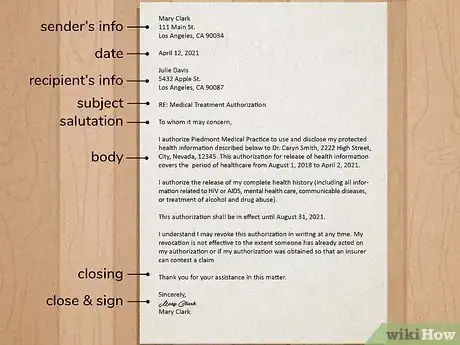
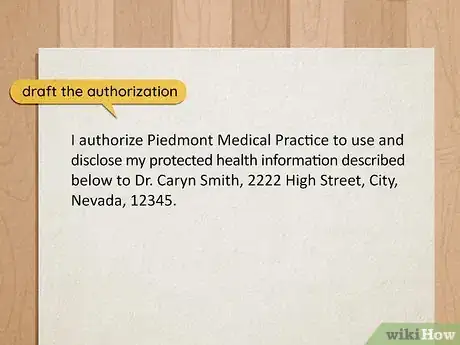
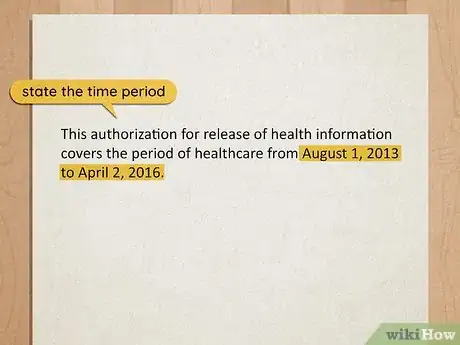
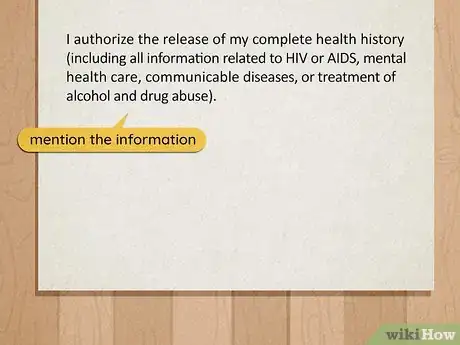


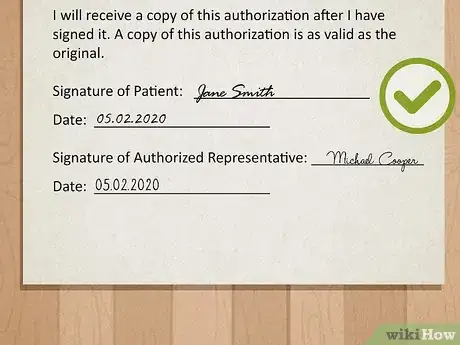
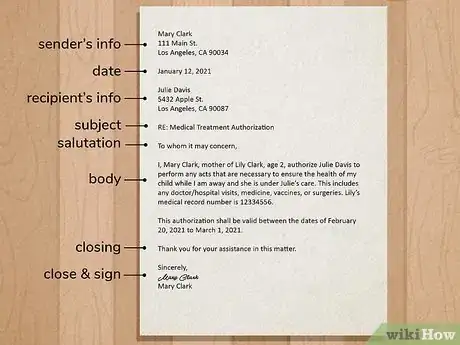
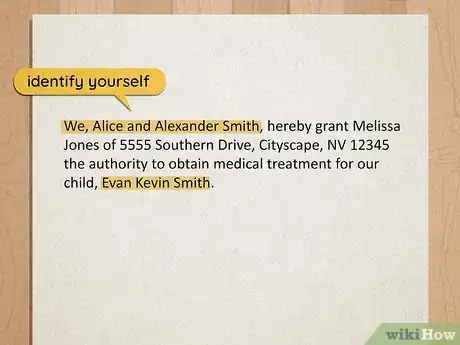
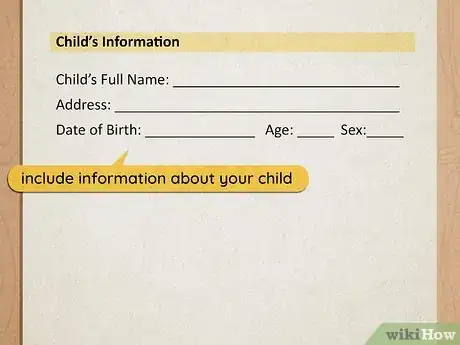
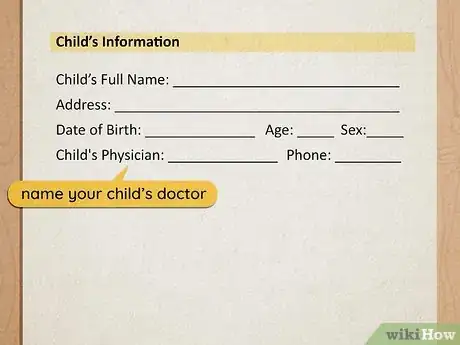

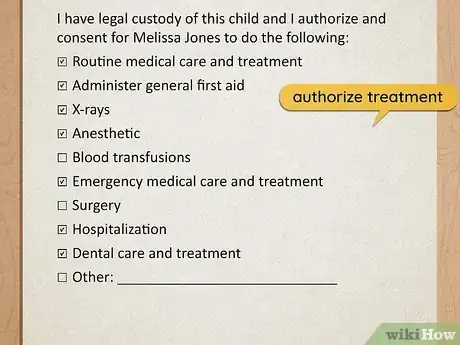

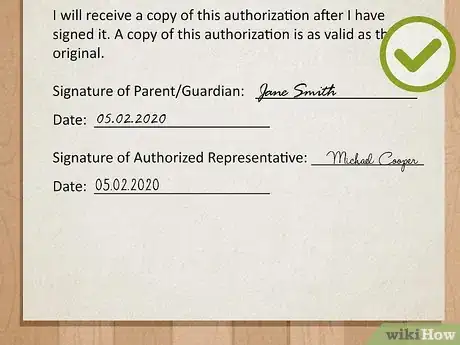
















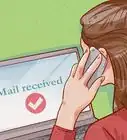





































Medical Disclaimer
The content of this article is not intended to be a substitute for professional medical advice, examination, diagnosis, or treatment. You should always contact your doctor or other qualified healthcare professional before starting, changing, or stopping any kind of health treatment.
Read More...